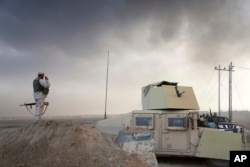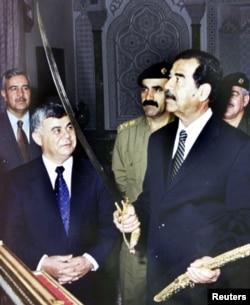Islamic State commanders, including founder Abu Bakr al-Baghdadi, are huddling in bunkers in Mosul, where they are directing the defense against an Iraqi-led offensive to retake the city, Iraqi military intelligence officials say.
We have intelligence that Abu Bakr al-Baghdadi and several of his close commanders live in those underground tunnels,” Major General Fadhil al-Barwari, head of the Iraqi Counter Terrorism Bureau, told VOA in a telephone interview from the front lines near Mosul.
Baghdadi, the Muslim fundamentalist religious teacher who declared the caliphate in Mosul in 2014, is one of the key targets for the invading Kurdish and Iraqi forces. He has much invested in Mosul, from directing IS brutality against residents to dictating its latest defense plans, analysts say.
Rumors of Baghdadi’s death surfaced recently. But allied intelligence officials say they now believe he is still in Mosul.
Hoshyar Zebari, a senior Kurdish official and Iraq’s former finance minister, told Reuters news agency that based on “solid intelligence reports,” Baghdadi and IS explosives expert Fawzi Ali Nouimeh remain in the city.
"We don’t know (if) many (IS) leaders are left in Mosul,” Barwari said. “We do know, however, that many of their foreign commanders have been moved to border areas between Syria and Iraq.”
Before the Mosul offensive began on Sunday, intelligence reports said that some IS leaders moved out of the city into rural areas of Iraq and Syria. Top IS leaders prepared for the battle by ordering the digging of defensive trenches, creating tunnels and covering alleyways with sheets to shield fighters from airstrikes, according to intelligence reports.
It appears that IS commanders have set out a strategy of carrying out suicide attacks on Iraqi forces from the southern front and Kurdish forces from the eastern front. Once IS fighters have been cornered inside the city, Kurdish and Iraqi commanders say they expect IS to display thousands of civilian human shields and possibly unleash chemical weapons attacks.
On the battlefields around Mosul, former Baathist military men from the Iraqi regime of Saddam Hussein are helping to direct the IS fighters’ strategy.
Ex-Baathists, at odds with the Iraqi government, became aligned with IS as it emerged in 2014. They helped lead IS battles that seized territory in Anbar province and northern Iraq. Saddam-era military leaders found a cause in IS Sunni ideology which opposes the Shi’ite government leadership in Baghdad.
“Iraqi leaders know about Mosul better than foreign commanders of the organization and they have experience in fighting the Iraqi military,” said Watheq al-Hamishi, director of the Iraqi Group for Strategic Studies, a Baghdad-based group that advises the Iraqi government.
The ex-Baathists came into bigger play after IS foreigners were moved out of the city weeks before the offensive began, Hashimi said.
“They (IS) changed their entire leadership, empowered the former Baathists within its ranks and transferred foreign commanders and their families to other areas under their control,” Hashimi said.
Former Baathists are keeping a desperate population inside Mosul in check, analysts say.
“The Iraqi leadership within (IS) that enabled the rise of the would-be caliphate are the (same) commanders” largely administering Mosul, said Nicholas A. Heras, a Middle East researcher at the Center for a New American Security in Washington.
They are “most responsible for building alliances and networks within the local population that facilitated (IS’s) rise and rule,” he said.
But observers point out that ex-Baathists are less brutal than the foreign IS commanders, who have unleashed waves of violence inside Mosul.
“Many of (IS’s) foreign commanders are far more reviled than the local Iraqi (IS) commander,” Heras said. “The foreign commanders will be the first leaders of IS that will be singled out for attack by local residents of Mosul and the surrounding area.”








